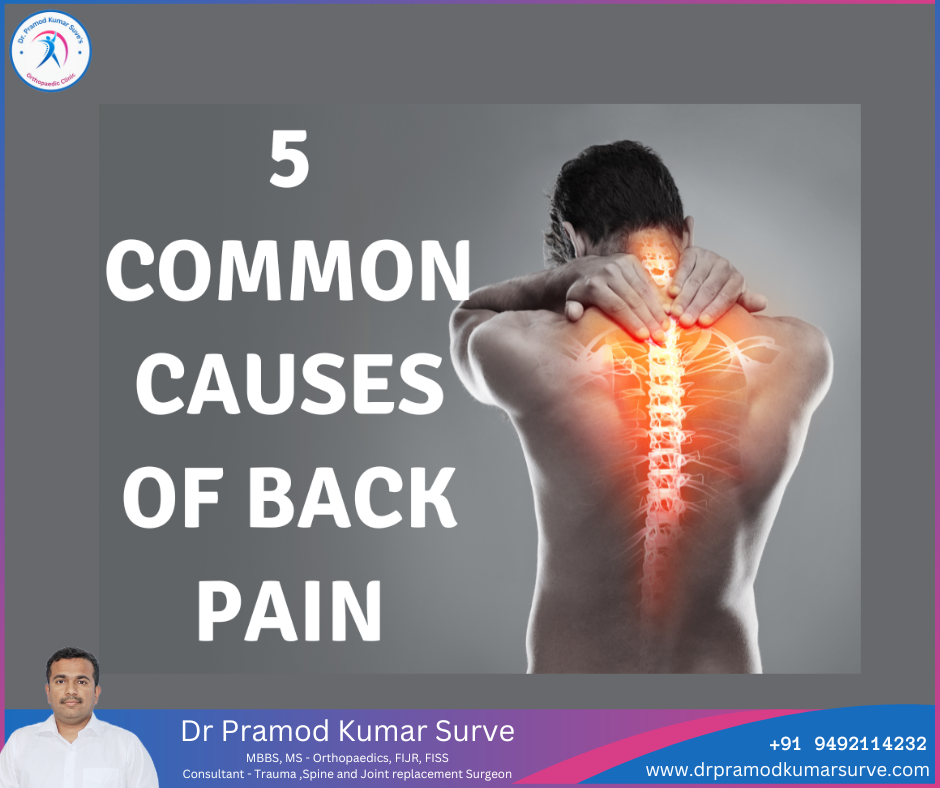Are you suffering from chronic back pain or discomfort and aren’t sure why? Back pain can have a serious impact on your daily life, and letting back pain go untreated can lead to worsening symptoms and even lasting damage.
Figuring out what’s causing your back pain is the first step toward back pain relief. These five common causes of back pain are prevalent for people of all ages and activity levels. An orthopedic doctor can treat these back conditions with a wide variety of different treatment methods.
Lifestyle
Many common causes of back pain result from lifestyle factors, especially when certain factors are combined. These factors can impact any age or gender and can result in acute or chronic back pain. Upper back pain, lower back pain, and middle back pain can all be attributed to a variety of common lifestyle factors. Common lifestyle factors that can cause back pain include:
- Lack of exercise: unused, weak muscles can lead to back pain as well as an increased risk of injury.
- Excess weight: Obesity puts extra strain on the muscles in your back, which can result in chronic back pain.
- Smoking: Smoking can lead to an increased risk of back pain and conditions that cause back pain, such as osteoporosis and herniated discs.
- Job factors: Jobs that require lots of heavy lifting, twisting, pulling, etc., can result in back injuries and back fatigue, especially if improper lifting techniques and overworked muscles are at play. Jobs that require lots of sitting can also cause back pain due to prolonged periods of sitting, poor posture, and an uncomfortable chair.
Treatment
- Lifestyle adjustments: Thankfully, all of these factors can be treated with what are often minor lifestyle adjustments. Regular exercise, increased stretching, quitting smoking, and education can all help get rid of back pain. Speaking with an orthopedic back doctor can provide insights into your risk factors, lifestyle, and what adjustments you can make to get rid of back pain for good.
- Physical therapy: Many people view physical therapy as a treatment for an injury or recovery after surgery. But physical therapy can help provide you with the tools and resources you need to stay healthy. Physical therapy can help boost your flexibility, build muscle, and learn the best exercises for your specific condition and lifestyle.
Pulled Muscle or Tendon
From exercising to lifting heavy objects improperly to sleeping in an awkward position, pulled-back muscles and tendons are extremely common. The good news is that regardless of how you hurt your back, most treatments for a pulled-back muscle or tendon are simple and non-invasive.
Pulled Muscle or Tendon Treatments
- Over-the-counter relief: Over-the-counter pain medication, ice packs, heating pads, and rest can all help relieve back pain from a pulled-back muscle or tendon. For more severe back injuries, it is best to see a doctor to determine more effective treatment options.
- Muscle relaxants: Inflammation and back muscle spasms can be symptoms of a pulled-back muscle or tendon, causing troublesome back pain. Muscle relaxants can be prescribed by a doctor to help alleviate these symptoms during your recovery period.
- Physical therapy: Aqua therapy, massage therapy, guided stretching, and more are just a few different forms of physical therapy that can help treat a pulled-back muscle or tendon. Physical therapy can also help prevent future back injuries by improving flexibility, building muscle, and providing patient education.
Arthritis
Acute back pain typically lasts 1–7 days, but when back pain lasts longer and comes back frequently, it is considered chronic back pain. If your back pain is not the result of a back injury or other lifestyle causes, it may be due to arthritis. Several types of arthritis are associated with a group of conditions known as spondyloarthropathy. This term means spinal arthritis, which can affect both children and adults.
Back Arthritis Treatments
Arthritis can be tough to diagnose and often requires blood tests, x-rays, and a trained eye. It is important to see a doctor if you think that you may have arthritis. Undiagnosed and untreated arthritis can lead to worsening symptoms and even eventual disability.
Osteoporosis
If you’re experiencing weakening grip strength, stooped posture, back pain, trouble getting up and down, and more, you may be suffering from osteoporosis. This condition causes bones to become weak and brittle and often results in fractures in the spine, hip, and wrist.
Osteoporosis Treatments
- Medications: A number of medications can be prescribed to help treat osteoporosis. These medications help by reducing the rate at which bones break down or by speeding up the bone-building process. These medications are usually in pill form but can also be done through IV infusions.
- Physical therapy: Physical therapy can help strengthen your bones and the muscles that support them. This can help slow deterioration and reduce the risk of a bone fracture in a safe environment with the guidance of a professional.
Disc Injury
A herniated disc (also called a slipped disc, bulging disc, or ruptured disc) occurs when a fragment of a spinal disc is pushed out of place. Lower back pain is often an early symptom of a herniated disc.
Herniated Disc Treatments
- Nonsurgical treatments: Over-the-counter care, prescription medications, physical therapy, and cortisone injections can all be used to treat a herniated disc. It’s important to discuss your treatment plan with a doctor to ensure the ideal treatment plan for you.
- Surgical treatments: If nonsurgical disc treatments don’t work and symptoms persist, orthopedic surgery may be the next treatment option. Typically, back surgeons are able to remove just the protruding portion of the disc and not the entire disc.
